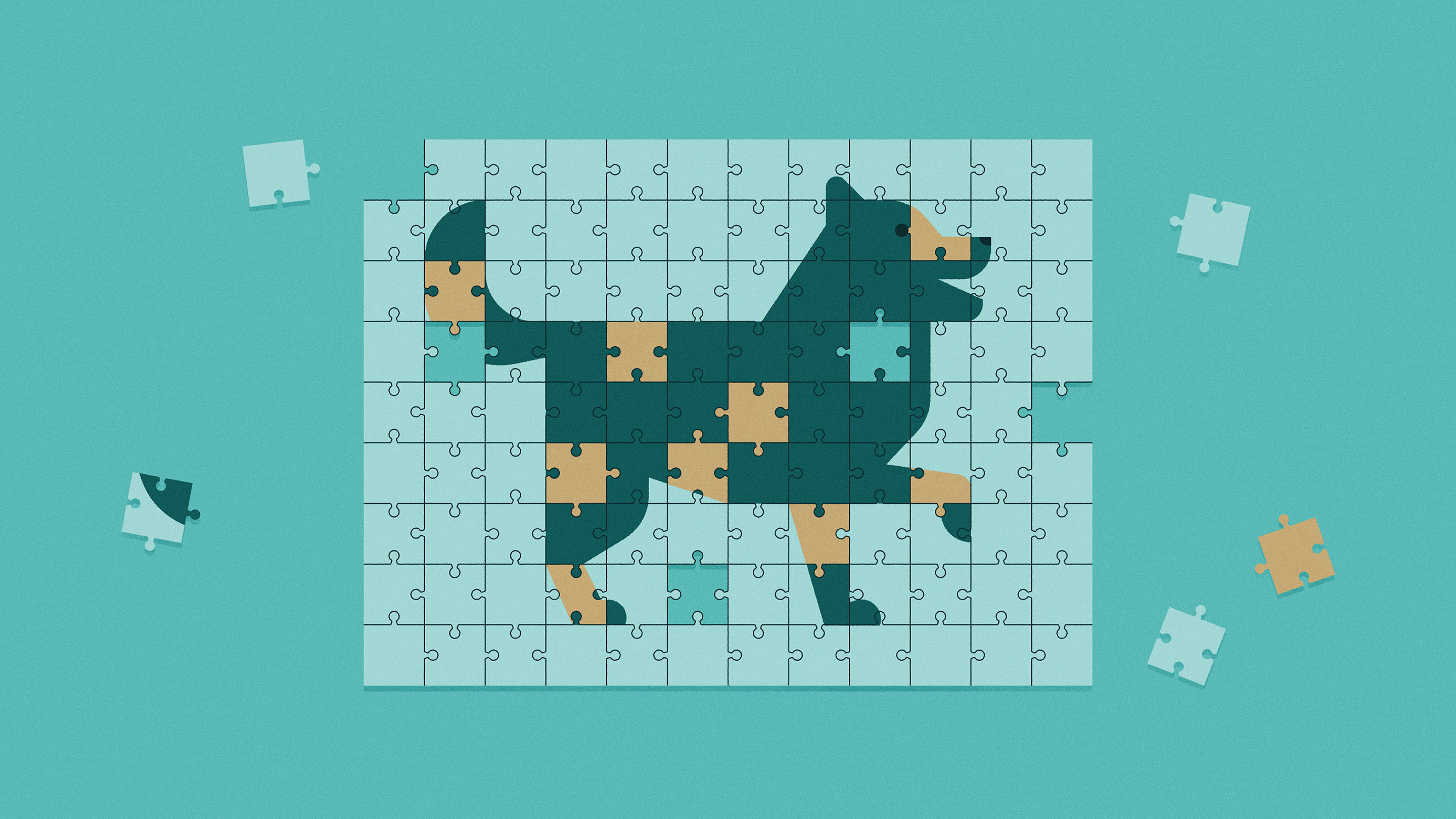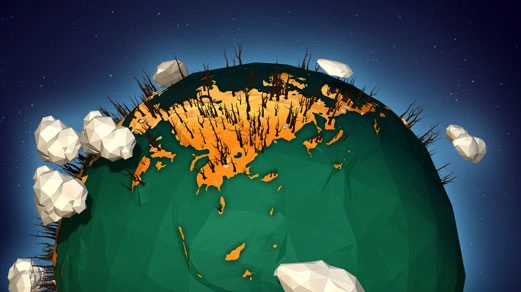How to Breed a Pomsky and Other Questions About Dogs and Sex

James Round for Quanta Magazine
Introduction
The cute puppy pictured below is the latest addition to my extended family. Dax is a “Pomsky” — part Pomeranian, part Siberian husky. His pedigree is the subject of our first puzzle.
Puzzle 1
Dax is certified to be 56% Siberian husky and 44% Pomeranian. Given that a cross between two purebreds is nominally considered to have an equal genetic mixture of both breeds, how is Dax’s unusual genetic makeup produced? What is the smallest number of generations needed to produce his genetic makeup to the nearest percentage point? (You must start with purebreds and cross their offspring only with each other or with purebred Poms or huskies.) If there is at least one purebred parent in every generation, are there more purebred huskies or Pomeranians in Dax’s ancestry?
Puzzle 2
Suppose Dax had a cousin, Max, who was 60% husky and 40% Pomeranian. What is the smallest number of generations it would take to produce a dog like Max using the same rules as in Puzzle 1? In general, what is the smallest number of generations needed to produce a Pomsky with any given percentage of “huskyness” to the nearest integer?
I mentioned above that an equal genetic contribution from both parents is only “nominally” true. In actual fact, only female offspring receive an equal mix of genetic material from both parents. Believe it or not, males of mammalian species receive more genetic material from their mothers than they do from their fathers! That’s because males inherit an X chromosome from their mother and the much smaller Y chromosome from their father. Females, on the other hand, inherit X chromosomes from both their parents. Both sexes also receive an equal quantity of genetic material as non-sex chromosomes (autosomes) from both parents.
Puzzle 3
The total quantity of genetic material in a genome can be measured by counting the number of DNA base pairs in it. All the cells of female dogs, except for egg cells, have two copies of each chromosome with a total of approximately 5 billion DNA base pairs. Of these, 50% go to each offspring through the egg. Female offspring receive an equal genetic contribution from their father’s sperm, including all the non-sex chromosomes and another X chromosome. For male offspring however, the sperm carries the rest of the chromosomes and the Y chromosome, which has about 100 million fewer base pairs than the X chromosome. Based on this information, what proportion of their genome do male dogs actually inherit from their mother? How does this affect the answer to Puzzle 1?
This is not just academic curiosity. The fact that women have two X chromosomes, one from each parent, while men have only one, has been theorized to be one reason why men are about twice as likely to die of COVID-19 as women worldwide. The X chromosome has genes that are involved in the immune response, and the double dose that women possess might give them a stronger, more diverse immune system.
Here are a couple of other thought-provoking questions about the COVID-19 pandemic that you might find interesting to consider.
Question 1
COVID-19 is known to be particularly devastating to the very old. The following data from the CDC gives the breakdown of about 70,000 COVID deaths in the U.S. by age group. It shows that people who are 85 or older are the most vulnerable. In this data, there were more males than females, although the ratio of male to female deaths was about 55:45, which is somewhat lower than in the rest of the world.
| Age Group | No. of Deaths |
| Under 1 | 3 |
| 1-4 | 2 |
| 5-14 | 7 |
| 15-24 | 76 |
| 25-34 | 463 |
| 35-44 | 1,186 |
| 45-54 | 3,338 |
| 55-64 | 8,312 |
| 65-74 | 14,447 |
| 75-84 | 18,621 |
| Over 85 | 22,543 |
However, as people get older, the number of years they can expect to live decreases. Which age group in the above table has lost the most years of life on account of COVID? Take a guess. In order to figure this out accurately, you have to use actuarial tables like this one, which shows that a 62-year-old man has an average life expectancy of another 20 years, while an 87-year-old can only expect to live another five years on average. Does the final answer surprise you?
Question 2
My final question is about a hypothesis that sounds fantastical and is highly speculative:
Could pandemics be the reason that mammals reproduce sexually instead of asexually? Did pandemics give us sex?
Consider the following points:
- Asexual reproduction is twice as efficient as sexual reproduction, if all individuals can reproduce, instead of just half the population. In addition, it eliminates the hassle of finding a mate (or learning how to use a dating app!). Another advantage is that in asexual species, just one individual can quickly colonize new territory. The asexual Brahminy blind snake, which looks more like a large worm, has been spread to six continents by single individuals hitchhiking in flower pots!
- Sex, of course, increases genetic diversity in an organism’s offspring, which might make them fitter and more adaptable. This is useful, especially in adverse circumstances. But the efficiency of asexual reproduction often wins out at other times. As Christie Wilcox wrote in a recent Quanta article, many simple animals use both asexual and sexual reproduction, using the latter only in difficult times.
- Most lizards can reproduce asexually using a process called parthenogenesis, in which a female can reproduce without the genetic contribution of the male. About 50 kinds of lizards reproduce exclusively by asexual means (obligate parthenogenesis), plus the one species of snake mentioned above.
- If reptiles can do it, why not mammals? Contrary to what one might expect, sperm is not absolutely necessary for mammalian eggs to start dividing. The right chemical stimulus can cause a mammalian ovum in a lab, even a human one, to start dividing and producing an embryo without sperm. So there must be an evolutionary reason why mammals have lost the capacity to activate those pathways naturally.
- One of the leading theories behind why sexual reproduction is necessary is the Red Queen hypothesis — the idea that sexual reproduction helps large animals keep one step ahead of rapidly evolving microscopic infectious agents.
- Pandemics are the hammer blows of such infections, and they affect large animal populations several times a century. The devastating ease with which pandemics level asexual populations, as was the case in the Irish potato famine, is well known. If the Black Death could kill 30%-60% of the genetically diverse sexually reproducing human population in Europe in the 14th century, what could it have done to an asexual version of us? An asexual population is the equivalent of putting the same genetic lock on every house on the street. A bacterium or virus that happened to find the right key could render such a species extinct in one fell swoop.
So maybe, just maybe, pandemics were responsible for making us the obligate sexual creatures we are!
What do you think about this hypothesis? Comments welcome, and happy puzzling!
Editor’s note: The reader who submits the most interesting, creative or insightful solution (as judged by the columnist) in the comments section will receive a Quanta Magazine T-shirt or one of the two Quanta books, Alice and Bob Meet the Wall of Fire or The Prime Number Conspiracy (winner’s choice). And if you’d like to suggest a favorite puzzle for a future Insights column, submit it as a comment below, clearly marked “NEW PUZZLE SUGGESTION.” (It will not appear online, so solutions to the puzzle above should be submitted separately.) Update: The solution has been published here.
Note that we may hold comments for the first day or two to allow for independent contributions by readers.



